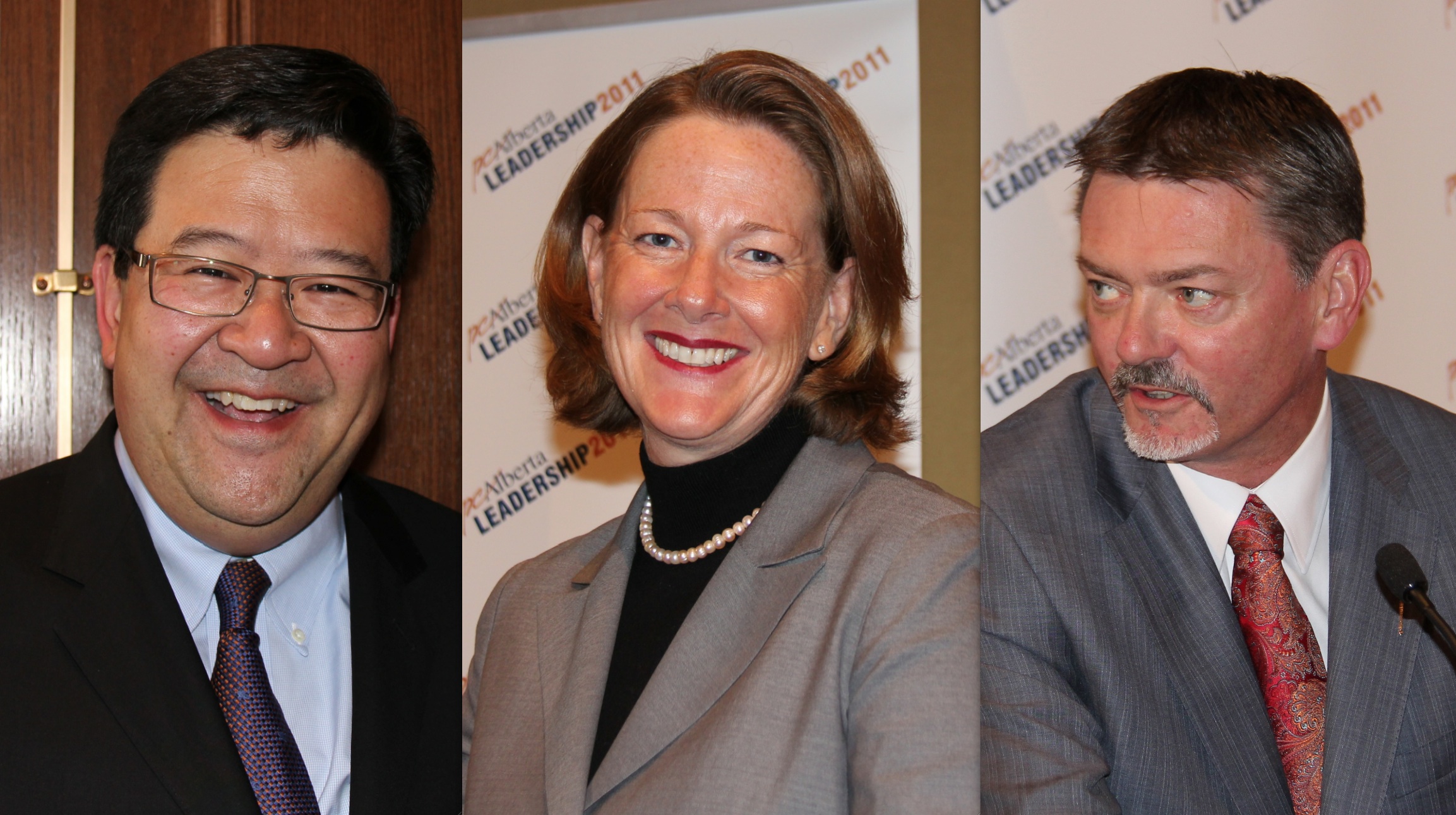With two weeks of electioneering to go until the final ballot in the Alberta Progressive Conservative leadership election, any of the three candidates still standing after Saturday’s first-ballot vote could emerge as the winner.
So it seems highly unlikely any of the three will drop out of the race “for the good of the party” before Oct. 1, as some naïve observers were suggesting in the wake of the ballot counting Saturday night.
That said, with more than 13,000 votes over second-place finisher Alison Redford, Gary Mar remains the front-runner by a considerable, some would say comfortable, margin.
He is far better positioned to win than either Redford, the former justice minister in Premier Ed Stelmach’s cabinet, or third-finishing Doug Horner, former deputy premier and holder of numerous important cabinet posts, notwithstanding the fact both challengers have proved they are formidable campaigners.
Talk of third-place candidates “coming up the middle,” as Stelmach did in 2006, is almost irresistible to professional political pundits, not to mention mere amateurs like your blogger. However, sometimes we should all know better — or at least take a deep breath before we bloviate.
The first-ballot strength enjoyed by Mar — a Calgary lawyer, former minister in Ralph Klein’s cabinet and the sometime chief apologist of Big Oil’s Tar Division in Washington, D.C. — puts him in a significantly more likely position to win on the second ballot than the first-place winners in the Conservative leadership contests of either 2006 or 1992, both of whom turned into losers in the second round.
In 2006, famously, Calgary oilman and former cabinet minister Jim Dinning, whom everyone simply assumed would win, led the second-place candidate, Ted Morton, by 3,856 votes on the first ballot. This enabled Stelmach to make his unexpected dash for the finish line. Alas for Stelmach, while he proved to be a champion sprinter, the premiership of any Canadian province requires one to run a marathon.
In 1992, Nancy Betkowski, another former Tory cabinet minister, led Klein on the first ballot — but by only a single vote. We all know how that one turned out, and her attempt to unseat Klein with a different name at the head of a different party as well.
Mar’s lead today, by contrast, is of a different magnitude entirely. It would be fair to say that as a result, the race remains his to lose.
Indeed, it’s an interesting question to ask, why a candidate with Mar’s formidable advantages — years of planning, deep pockets, enviable position as an outsider unsullied by the mistakes of the Stelmach Era, and the blessing of the PC Party establishment — couldn’t finish the job on the first ballot?
Possible reasons for his lack of decisive success — and Redford’s unexpected second-place finish — might just include the fact he was so identified with the party establishment and its determination to pursue a number of policies that a lot of Conservative traditionalists were uncomfortable with. Examples: Increasing oil royalties, deficit budgets and anything that smacks of interference with large landowners’ “property rights.”
Still, Mar remains the consensus choice, at least of the PC Party’s leadership.
Redford, by contrast, adopted an abrasive outsider’s style, harshly criticizing the party establishment and appealing to the many Albertans who may not be Tory Party insiders but who nevertheless registered to vote in the belief this contest is the best — maybe the only — expression of real democracy in a one-party province.
Ignoring the wishes of the party’s power elite to call for a judicial inquiry into intimidation of health care professionals, as alleged by the new leader of the Opposition Liberals, is a good example.
But it’s less clear if this can be as effective in the narrow window before the final vote, when the establishment is playing for keeps and long-time Tories who supported other candidates are looking for a candidate to back.
Horner, by contrast, epitomizes the idea that slow and steady may yet win the race. If Redford is tapped out, having already scooped up all the rebels and outsiders, Horner may have the potential for considerable growth among party insiders who for whatever reason don’t fancy Mar, but still self-identify as Conservatives.
Making things murkier is the fact the makeup of the electorate that will vote on Oct. 1 is no longer clear.
That’s partly because candidates are allowed to continue selling memberships right up until the vote on Oct. 1. They’re all now in possession of electoral machines capable of selling large numbers of memberships and delivering their votes.
It’s also because it’s impossible to know how the supporters of the three defeated right-wing candidates will behave. Will they stay home and pout? Will they move back to the Wildrose Party? Will they try to cut a deal with one of the three candidates to enact the kind of policies they always lobby for?
Because of the size and unpredictability of this voting bloc, and renewed worry about how the fate of the three most extreme right-wingers might revitalize the Wildrose Party, we may see the rhetoric in this race swing back to the right.
Finally, there remains the possibility of another September Skeleton lurking in one of the candidates’ closets, like the CBC’s revelations about defeated candidate Ted Morton’s secret “Freddy Lee” email account that altered the dynamics of the first-ballot race.
This is unlikely to be raised by any of the candidates themselves — after all, they may have to work together again. But perhaps some reporter is even now drafting a question that may send the campaign in an unexpected direction.
The upshot? It’s still close. … but not too close to call.
This post also appears on David Climenhaga’s blog, Alberta Diary.




